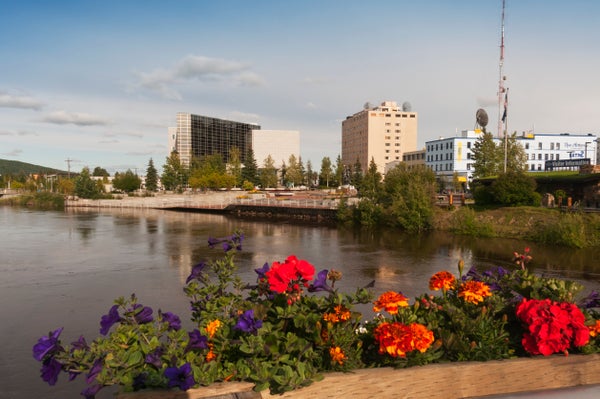Alaskan Heat Wave Will Send Temperatures Soaring to 90 Degrees F

It’s Going to Hit 90 Degrees in Alaska This Week
Temperatures in Fairbanks, Alaska, are predicted to reach a record-tying 90 degrees Fahrenheit because of a prolonged, unusually late heat wave
Downtown Fairbanks, Alaska skyline.
Temperatures in Fairbanks, Alaska, are forecast to hit 90 degrees Fahrenheit (32 degrees Celsius) on Wednesday—hotter than the expected highs in New Orleans, Atlanta and Washington, D.C., that day. In fact, it will be hotter in Fairbanks than much of the contiguous U.S. east of the Mississippi River. The expected temperature in the Alaskan city would tie a record for that date, and the heat could exceed it.
The unusually soaring temperatures in Alaska’s interior are the result of a “very, very strong bubble of warm air, of high pressure that has set up over Alaska,” says Greg Michels, a meteorologist on a temporary detail at the National Weather Service’s (NWS’s) office in Fairbanks. Though such heat events are not unheard of there, this one is unusually strong and persistent for this time of year.
The high-pressure system settled over the area on Friday. Because such systems are essentially domes of air, they can act like a shield against storms that can bring cooler air. The recent one over Alaska has “been keeping weather systems off to the north and west of us,” Michels says. With the sun streaming down through cloudless skies, “it’s allowing the air to heat up pretty good, and we’re getting close to record highs.” The heat is expected to peak in Fairbanks on Wednesday. If the thermometer does hit 90 degrees F, it would tie the record for that date set just last year. And the temperature could be warmer still in some other spots around the Alaskan interior. Typical July temperatures are in the 60s or 70s F.
On supporting science journalism
If you’re enjoying this article, consider supporting our award-winning journalism by subscribing. By purchasing a subscription you are helping to ensure the future of impactful stories about the discoveries and ideas shaping our world today.
Interior Alaska does periodically see these types of heat waves: the hottest temperature ever on record in Fairbanks was 96 degrees F, set on June 15, 1969. But the event this week is unusually late in the summer.
That may sound odd to those dwelling in the Lower 48, where summer heat tends to peak in July and August. But Alaska’s Arctic location means that by late July, Fairbanks has already lost more than two hours of sunlight since the summer solstice, “so there’s just less time to accumulate solar heat,” says Brian Brettschneider, a climate scientist at the NWS’s Alaska Region Headquarters. In Houston or Atlanta or Saint Louis, the temperature could reach 100 degrees F anytime between late May and late August, he adds, but “that just cannot happen here … because you need that sun angle, the hours of daylight.”
When such events occur in Alaska, they typically happen in late June or early July, when the sun is at its peak in the sky. Since 1930, there have only been 25 years where Fairbanks had at least one 90-degree-F day, and in those years, there have been only a total of 45 such days, Brettschneider says. Only six 90-degree-F days have occurred this late in the summer.
Though it’s clear that Alaska is getting hotter—just like the entire globe—picking out trends in these record-breaking heat waves is difficult because these events are so rare. The fewer data there are, the harder it is to pick out a climate change signal.
Experts are concerned for people’s health this week because residents aren’t acclimated to even this level of heat, which wouldn’t be unusual for large swaths of the rest of the country. “Hot for us is over 70” degrees F (21 degrees C), says Uma Bhatt, a climate scientist at the University of Alaska Fairbanks.
Adding to the public health burden is the lack of central air-conditioning in Alaska’s homes, Brettschneider says. Instead “you’ve got homes that are built to maximally keep every molecule of heat inside,” he says.
Window units are available, and people have been increasingly buying them, Bhatt says. “You go to Costco, and the air conditioners are all gone,” she adds. Bhatt and her husband have been sleeping in their basement because the sun has been baking the window-filled bedroom on the upper floor of their house. “It’s hot as hell up there,” she says.
Officials caution that people need to be aware of the risks of excessive heat, just as elsewhere in the country, and to take precautions: to limit time outside in the sun during peak heat, seek means of air-conditioning if possible and be aware that homes may not cool much at night. “People will need to take it a little bit easier,” Michels says. This will likely be “the hottest air of the summer up here.”